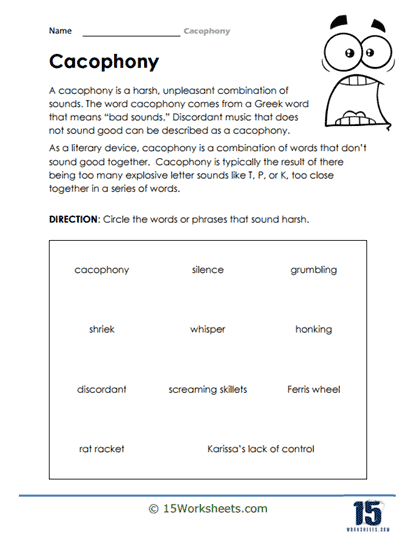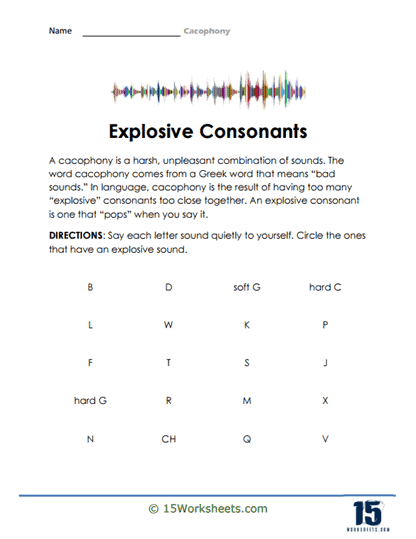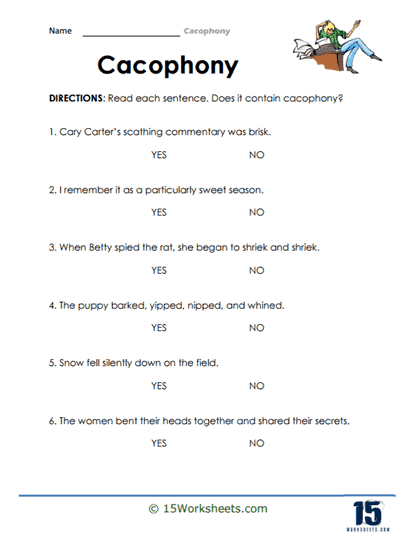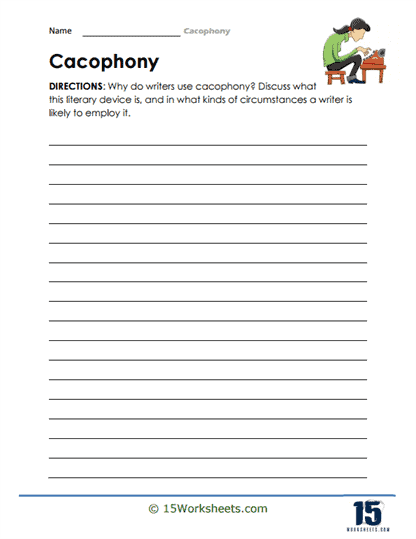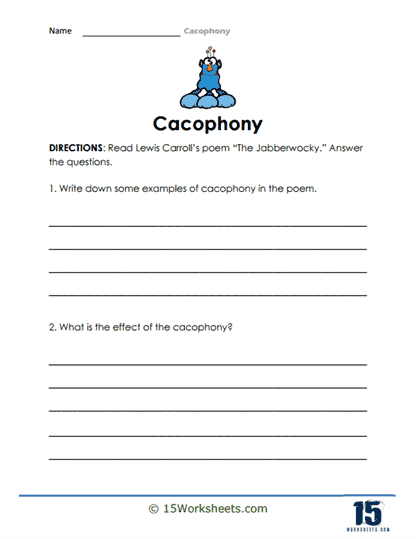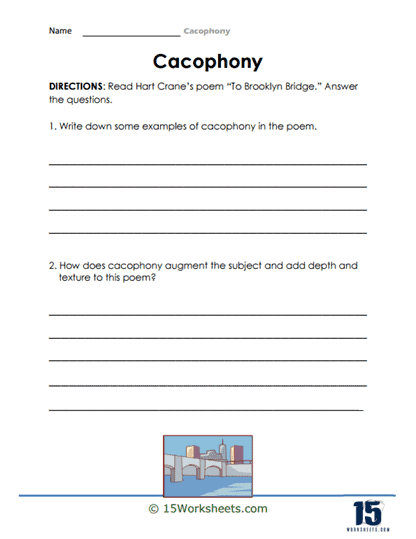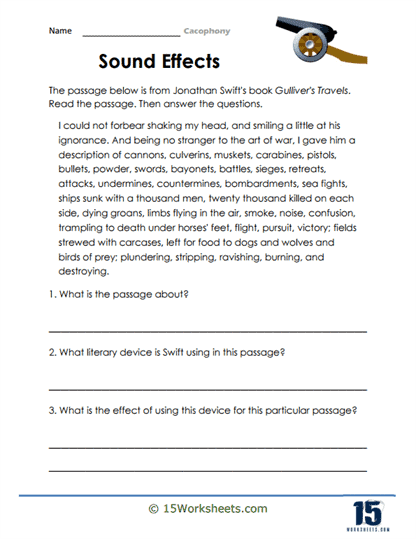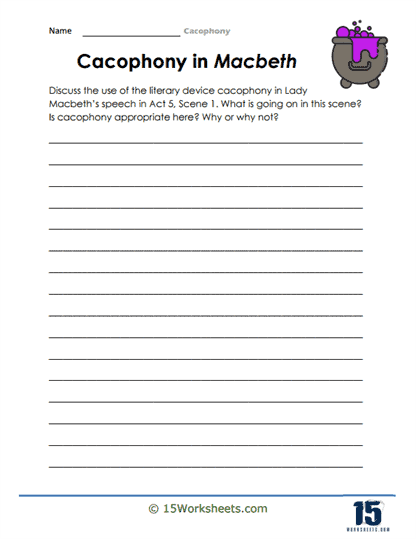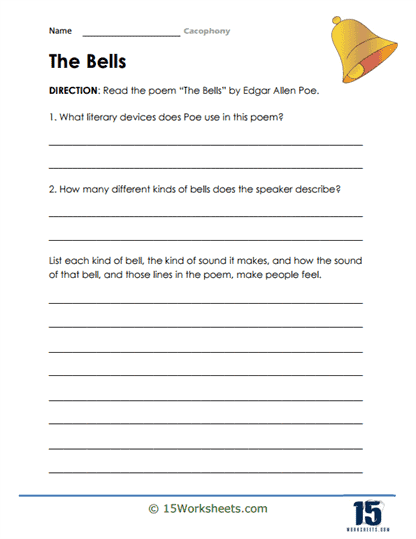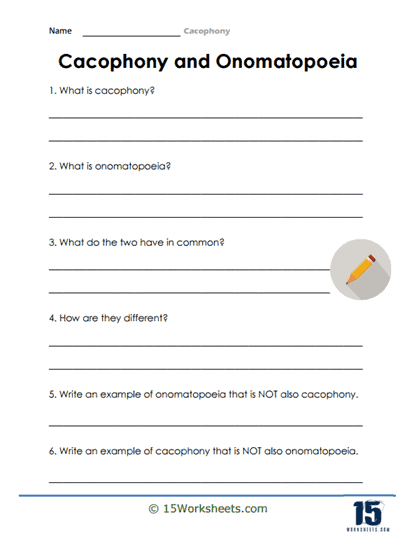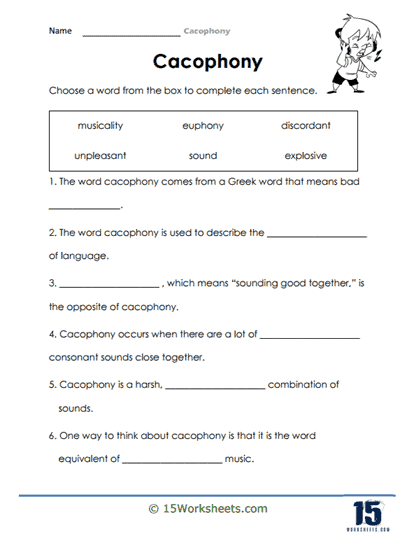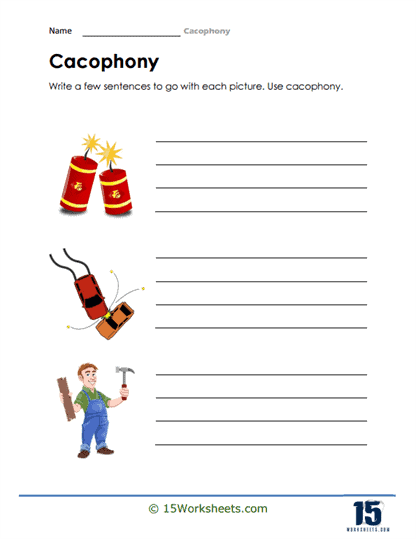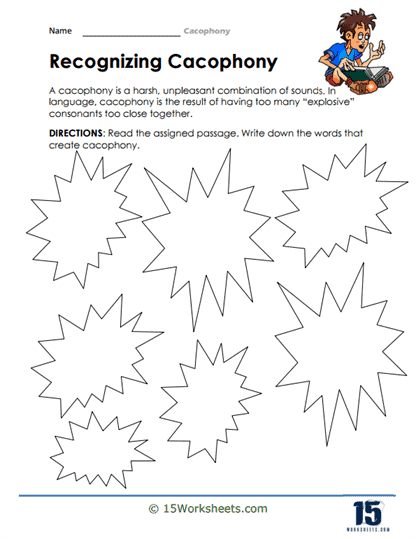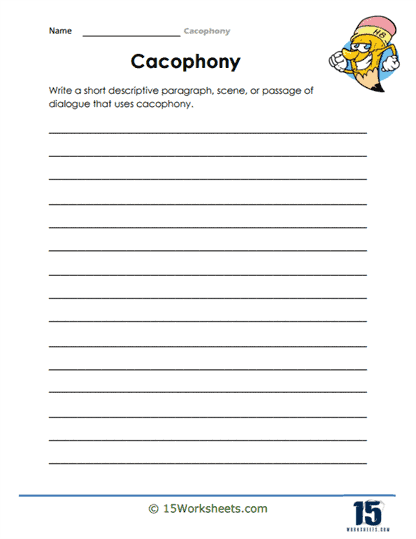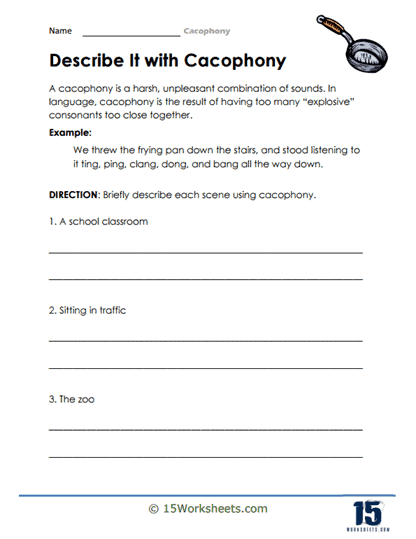Cacophony Worksheets
All About These 15 Worksheets
Cacophony, the deliberate use of harsh, jarring, and discordant sounds in language and literature, is a powerful and evocative element of creative expression. Understanding and effectively employing cacophony not only deepens a student’s appreciation for the artistry of language but also enhances their writing, critical thinking, and communication skills.
In a world where effective communication, emotional impact, and creative expression are essential, students must develop the ability to recognize, analyze, and use cacophony to convey complex emotions and ideas. To empower students with the knowledge of cacophony and its diverse applications, we proudly present a collection of 15 worksheets. These worksheets are meticulously designed to provide students with structured and engaging opportunities to explore, practice, and master the use of cacophony.
These contains contain a set of exercises intended to help students understand and identify the use of cacophony in poetry or prose.
The exercises that you will find on these worksheets includes:
Identification of the Technique – Students are given a set of sentences or paragraphs and are asked to underline or highlight words that create a cacophony. Students are provided with a piece of text that uses cacophony, and are asked to write a short response on how the use of cacophony contributes to the overall mood or tone of the text. Students are asked to find examples of cacophony in books they’ve read or are reading.
Create a Cacophony – Students are asked to write their own sentences or short paragraphs using words that create a harsh or jarring sound effect. Students are given a sentence or paragraph and are asked to rewrite it in a way that introduces cacophony.
Cacophony vs. Euphony – Students are asked to differentiate between cacophony (harsh sound) and euphony (pleasant sound) in a given text.
What is Cacophony?
Cacophony, derived from the Greek word “kakophonia” meaning “bad sound”, is a literary device that refers to the use of words with sharp, harsh, dissonant, and jarring sounds. By creating an auditory discord, cacophony effectively commands the reader’s attention, immersing them further into the text. It also helps to convey a particular mood or atmosphere, usually one of disorder, tension, or discomfort.
One of the main defining features of cacophony is the usage of consonants in quick succession, especially the plosive and fricative sounds such as k, p, d, g, s, z, and others. This use of cacophonous words effectively creates a linguistic roughness that can be jarring to the ear, making it a powerful tool in a writer’s arsenal to manipulate mood and sensory impact.
In addition, cacophony often manifests in conjunction with irregular and uncomfortable rhythm, jumbling up the usual flow of reading to further amplify the effect. It’s not just about the individual words but the overall soundscape created by the combination of those words. This can greatly enhance the text’s emotional resonance, making it more gripping or disconcerting.
Primary Examples of Cacophony in Literature
“Jabberwocky” by Lewis Carroll
This nonsense poem from “Through the Looking-Glass, and What Alice Found There” is replete with cacophonous sounds and words that create an unsettling mood fitting for its monstrous subject. Consider the opening verse – “Twas brillig, and the slithy toves / Did gyre and gimble in the wabe.” Words like “brillig,” “slithy,” “gyre,” and “gimble” create a rough, harsh sound, which combined with the poem’s irregular rhythm, accentuates the bewildering and disconcerting atmosphere. It adds to the mystery of the Jabberwocky and helps paint a vivid image of an ominous and unsettling world.
“Dulce et Decorum Est” by Wilfred Owen
This World War I poem uses cacophony to paint a stark, grim picture of war. Consider these lines – “Gas! GAS! Quick, boys!–An ecstasy of fumbling, / Fitting the clumsy helmets just in time.” The harsh ‘g’ and ‘b’ sounds in “Gas! GAS!” and “boys” as well as the rapid, clumsy cadence of “fumbling” and “Fitting the clumsy helmets” effectively convey the urgency, chaos, and sheer terror of a gas attack. This serves to further Owen’s anti-war message, giving the reader a chilling auditory snapshot of the horrors of war.
“The Raven” by Edgar Allan Poe
In this iconic poem, Poe uses cacophony to underline the protagonist’s spiraling descent into madness. For instance, take the line, “And the silken, sad, uncertain rustling of each purple curtain / Thrilled me—filled me with fantastic terrors never felt before”. The ‘s’ and ‘c’ sounds in “silken,” “sad,” “uncertain,” “curtain,” create a harsh, whispering sound, while the repeated ‘t’ and ‘r’ sounds in “rustling,” “thrilled,” “terrified,” produce a rattling effect. Together, these cacophonous sounds create an auditory atmosphere of fear and paranoia, enhancing the sense of dread and suspense central to the poem.
This is a powerful literary tool for creating a dissonant, harsh soundscape that not only enhances the sensory experience of a text but also aids in the thematic and emotional conveyance. By introducing cacophony into their work, authors can affect the reader’s experience, shape the text’s atmosphere, and further underline their narrative or thematic intentions. Despite its name suggesting “bad sound,” when used strategically, cacophony can result in profoundly impactful literature that resonates with its audience on an auditory and emotional level.
The Importance of Understanding Cacophony
Understanding cacophony and its various forms is of great importance for several reasons:
- Literary Appreciation: Cacophony is a fundamental element of poetry and prose, contributing to the aesthetic and emotional impact of literary works. Recognizing cacophony enhances students’ appreciation of language as an art form.
- Emotional Expression: Cacophony can convey complex emotions and sensations, making it a valuable tool for writers and speakers to evoke specific responses in their audience.
- Critical Analysis: Recognizing and analyzing cacophony in literature challenges students to think critically about the ways in which sound and language contribute to meaning.
- Effective Communication: Proficiency in understanding and employing cacophony sharpens students’ communication skills, allowing them to use language more creatively and persuasively.
This collection of Cacophony worksheets is a valuable resource for educators and parents committed to nurturing literary appreciation, creativity, and critical thinking skills in students. Proficiency in recognizing, analyzing, and employing cacophony equips individuals with the tools to communicate more effectively, convey complex emotions, and engage with language as an artistic medium.
This collection is an investment in their future success, ensuring they have the skills to appreciate the artistry of language, use sound and rhythm to convey meaning, and engage in creative and persuasive expression in a world where language is a powerful tool for communication and artistic expression. Explore these Cacophony worksheets today, and watch your students become skilled wordsmiths and discerning interpreters of the artful use of discordant sounds in language and literature.

